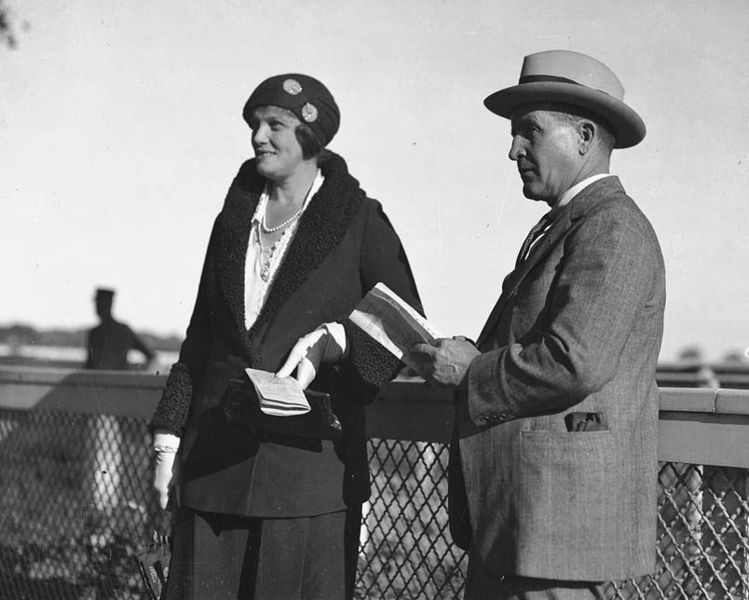 |
| Harry and Eunice Oakes visit a racetrack in Toronto, some time in the 1930s |
In 1943, U.S.-born Sir Harry Oakes, a tough old examiner who became, according to some, the world’s richest man, was murdered. The Bahamas’s number one citizen, Sir Harry was catered to by the duke of Windsor, the former king of England and then-governor of the islands.
In the aftermath of Sir Harry’s death in 1943, kept secret by the duke for some hours, ensued one of the most inept police investigations, and probably the most celebrated murder trial, of the war years. The duke of Windsor, after the discovery of the body, called in American lawmen to investigate, informing them that Sir Harry had committed suicide—a remarkable observation since Sir Harry had died of massive head wounds made by some kind of pronged instrument. What’s more, the bed where Sir Harry lay had been set ablaze and the dead man’s body incinerated. In a macabre touch, feathers were spread over the burned corpse. Clearly this was no run-of-the-mill suicide!
But if it wasn’t suicide, that meant the investigation run by imported Miami police captain Otto Barker and Edward Walter Melchen was aptly described by one authority as “one of the most lackadaisical criminal investigations of modern times.” There was considerable evidence that the murder was committed by American gangsters seeking to infiltrate the island for gambling purposes.
  |
Harry Oakes had the prestige and power to get the official okay for such activities, but the former gold hunter who hit the second largest gold strike in history was a contrary individual who could give his word one moment and break it the next. It appeared he had taken $1 million as a downpayment from a leading American mobster operating out of Miami, Meyer Lansky, and then refused to push for the establishment of a casino in Nassau.
The Florida investigators developed no interest in their fellow Miamian and instead came up with “evidence” that pinned the murder on Sir Harry’s unwanted son-in-law Alfred de Marigny, an aristocratic Frenchman from Mauritius, who though handsome and charming, was suspected by Bahamian society of being a bad sort.
The trial proved to be a sensation and the social event of the year on the islands. Wealthy landowners had their servants queue up for seats at the trial long before dawn. De Marigny was tied to the murder by tainted evidence, particularly a fingerprint of very dubious origin and worth. The prosecution’s case was built on innuendo. De Marigny had a bad reputation and wanted his father-in-law’s money. Sir Harry disliked him intensely and was not about to give him any money. His son-in-law murdered him.
The defense’s case was aided by the highly professional work of a famed American private detective, Raymond Schindler, who had to contend with all sorts of roadblocks set up by the local authorities. He was denied access to many matters, was followed and his telephone tapped. Yet he easily destroyed the prosecution’s case—a conclusion approved by Erle Stanley Gardner, one of the many writers assigned to cover the 13-week trial. It took the jury only two and a half hours to clear de Marigny.
But who killed Sir Harry Oakes? The royal government was decidedly uninterested in finding out thereafter. There are law enforcement agencies in the United States whose investigators have been convinced by a number of underworld informers that they have discovered the true story. The thesis, presented in a number of recent books on the case, has Lansky more than a little upset by Sir Harry’s refusal to go through with his agreement.
Lansky insisted that a local mild-mannered Bahamian real estate man named Harold Christie (who no one at the time knew had a Boston police record) was in on the deal to get Sir Harry to see the light. Christie knew what the underworld did to men who crossed them, knew that Sir Harry’s high position would offer him no protection.
Finally, the story goes, Lansky said he was sending a special emissary to settle matters once and for all. He was accompanied by four button men who arrived aboard a fast power cruiser on the afternoon of July 7, 1943. Christie and Sir Harry drove down to the docks and went aboard the craft.
Sir Harry, rather than Lansky’s emissary, did most of the talking and yelling. He said he had no intention of letting gangsters get a foothold on the islands. Lansky’s emissary said nothing, but he nodded slightly to one of the enforcers. Sir Harry went down hard when hit in the head with a four-pronged winch handle.
Christie was terrified by the sudden violence, but Lansky’s man assured him Sir Harry was only stunned. He had the real estate man and one of the button men pack the millionaire into the car and take him back to his mansion. There it was obvious that Sir Harry was never going to wake up again.
Christie was frozen with fear, but Lansky’s operative went about the grisly task of undressing the dead man and getting him into pajamas. Then the bed was set on fire, followed by the corpse. The feathers were a lastminute detail, intended apparently to give the killing a bizarre touch. Christie was left to say whatever he wanted, but he could not mention Lansky or his enforcers at all.
Of course, the Oakes case was never officially solved and Lansky had not been tied to it in any firm way by 1963, when, 20 years after the murder, Lansky got his gambling monopoly in the Bahamas. According to later investigation, the cost to Lansky to get the fix in was approximately $1 million—the same amount offered Sir Harry Oakes.